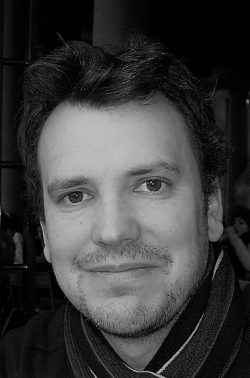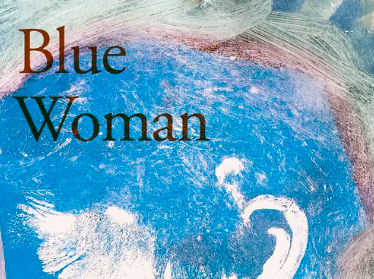Jonathan Page recounts his journey into the world of art, and writes on how his novelisation of the life of Welsh painter Rose Hartwood in Blue Woman might have helped inspired his own artistry.
My novel Blue Woman is the fictional biography of a 20th century Welsh painter, Rose Hartwood. Her story began, perhaps, as an unfulfilled longing on my part to draw again and make art. I like drawing but can’t seem to do it. Something stops me, a stand-off between my desire and that faint, long held note of shame about not doing so. Sometimes I make the odd, frenzied sketch of a bottle or a cup, the books on my shelves, during a particularly lengthy Teams meeting for work, but most of the time that’s it t.
I stopped drawing, but started to learn about contemporary art and artists in my early twenties. I found rest and vision in the cool halls of the Tate, what is now Tate Britain. I discovered Auerbach and Bomberg’s Mud Bath. I learned the names of the Camden Town Group and grew to love the bright, anthropomorphic forms of Antony Caro’s sculptures. I’m not sure why I put down my sketchpad. My best guess is that I was afraid of failing at something precious to me, and subsequently tainting it forever. Art was something I needed to preserve from the trials of early adulthood, from exams and breakups, the struggle to find a meaningful job. I had no such problem with English and writing: I flowered there, I kept on, down the long years. Meanwhile, art became something I experienced, rather than participated in. Painting, sculpture, made and found objects, helped me realise the sensual truth of things, and still does. Art connects and opens us.
Repression, then, led me in part to the life of Rose Hartwood. Through their work, I learned the lives of the artists I loved, from Velasquez to Rothko and Cy Twombly. I saw the variety there was, even in a Morandi, the slow passage and evolution of practice. I didn’t read up on biographical details at first, didn’t even touch monographs, afraid perhaps that they would get between me and the very personal relationship I’d set up with particular paintings and artists. Instead, I bought postcards and smothered my student walls – and later, hid them away in a wooden box that even now sits beside my writing desk. And I saw the journey through these images. Saw artists grow to old age in the work. I liked to theorise, even if I kept my ideas to myself.
I turned to books, at last, to substantiate my ideas. There was Herbert Read to start with, Tate guides to minimalism and surrealism, catalogues from exhibitions, and I learned too how artists stumble and fail and get up again. How it was never really settled, never guaranteed that Bonnard or Malevich should have made it to the gallery wall, though in hindsight it looks inevitable. I too had fallen many times by then, gone through divorce, seen my children grow. I knew that writing stories was a strange, perverse activity that might never lead to anything other than the drawer. I also knew I would keep doing it, not out of stubbornness, or perhaps not only that, but a kind of need. I saw how making art wasn’t exactly a choice for artists and might dictate the course of a life.
I was born on the Welsh borders, five miles into Shropshire, but it was only a few years ago that I came to Wales to live. The Black Mountains are a standing wave across the valley, a green wave and a white wave and a wave turned pink by the dying summer sun. I spend my days online, working on technical guides, talking to colleagues from all parts of the globe, but I am no longer bound to an office. There is no long, polluting commute now, and there is space to write creatively, for novels and short stories that, directly or indirectly, come out of the landscape that surrounds me. Coming to Wales also brought me to Rose. Her life begins and ends in the Marches, and her painting, like my writing, is interwoven with references to its people, towns and hills.

In the same way that I intuited the biographies of artists, learned from their paintings and sculptures, before I read their life stories, I went blindly into Rose Hartwood’s life. She was a short story first, an unmarried, teenage mother in the 1930s dealing with the loss of her child to adoption. Then she was another story, her experiences as an artist in wartime London, and then another, the creation of her painting, Blue Woman, in the early sixties. The unwritten connective tissue between these stories, and the desire to know what would happen to her next, led me to break the bones of what I had and refashion it as a novel. All that art I had absorbed over the years, my own experience of false turns and moments of fluency in my writing, helped me discover the kind of art Rose would make and when.
I love abstraction, I like big cast iron sculptures and a Ryman in an empty room, but I always knew that Rose was a figurative painter, and would remain so, throughout her life. Reality would dictate this in part, the art world she would enter in her teens, the surrealism of Paul Nash and the jagged, messy romanticism of Sutherland. And yet the figure would also be her quietly radical and subversive choice, as it was for Gwen John, that great painter of a previous generation. She would reclaim the body, consciously, unconsciously, from a male dominated art world, and her painting, Blue Woman would come to symbolise this.
And then there was the rest of Rose’s life, the other lives that intersect with and branch from hers, the rising and falling line of material and personal success. Art doesn’t always connect; the more I wrote, the more I saw how the stubborn pursuit of art could alienate Rose from those she loved. The empty rural world she returns to in middle age, as a refuge for herself and Ron, her husband, can’t save her marriage. Even so, the art she makes carries a positive force. Long after her death, Rose’s paintings and drawings help others, a party of school children, a cleaner, a picture restorer, those that survive and remember her and those that don’t, reinterpret and reinvent the world they see.
Blue Woman is about to leave me behind too, to go out into the world. Last week, I moved on from scribbled bottles and cups to sketching people and faces from a YouTube tutorial. It may be a one off, hardly proof of anything, but perhaps writing Rose’s story has shifted something in me. Perhaps writing a fictional life has allowed me to redeem something small from mine, one fumbled sketch at a time.
Blue Woman by Jonathan Page is available now via Weatherglass Books.
To learn more about Jonathan Page visit his website.












